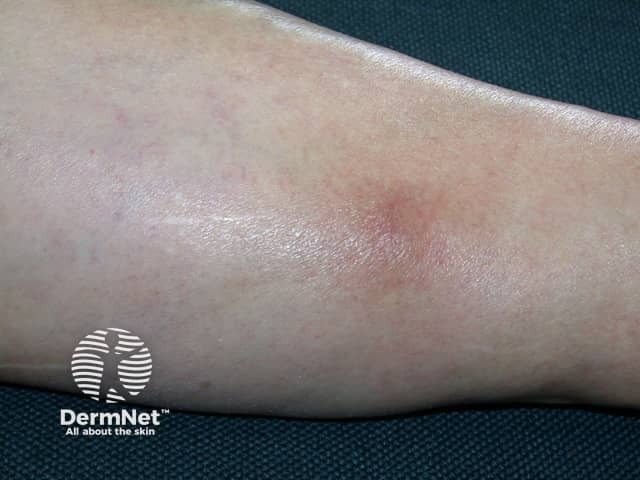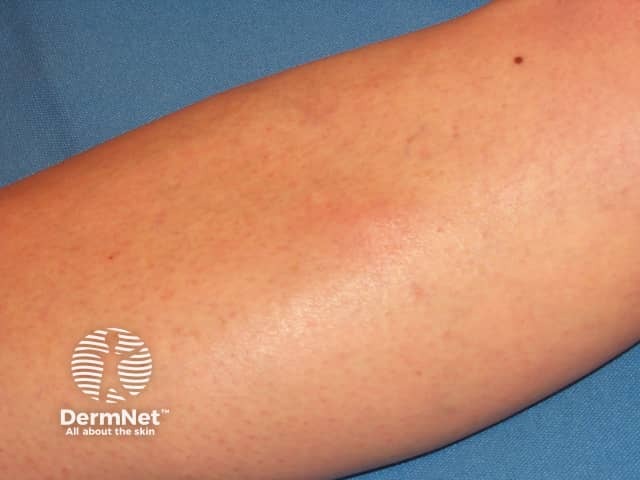Main menu
Common skin conditions

NEWS
Join DermNet PRO
Read more
Quick links
Superficial thrombophlebitis — extra information
Superficial thrombophlebitis
Author: Vanessa Ngan, Staff Writer, 2013. Minor revision, 22 February 2014.
Introduction
Causes
Demographics
Signs and symptoms
Diagnosis
Treatment
Outcome
What is superficial thrombophlebitis?
Superficial thrombophlebitis is an inflammation of a superficial vein due to a blood clot and is found just under the skin. It most commonly affects the veins in the leg but can occur in other veins around the body, for example, on the arms, penis and breasts.
What causes superficial thrombophlebitis?
The cause of superficial thrombophlebitis is not completely clear but it is believed to be associated with a change in the dynamic balance of haemostasis. In 1846, the German pathologist Virchow showed that damage to a blood vessel wall, abnormal blood flow, or a change in blood constituents causing abnormal blood clotting, could lead to inflammation or formation of blood clots in the veins.
Who gets superficial thrombophlebitis?
Superficial thrombophlebitis can occur spontaneously and without apparent reason.
Risk factors for superficial thrombophlebitis
- History of superficial phlebitis, deep vein thrombosis, and pulmonary embolism
- Varicose veins — people with varicose veins are prone to minor injuries of the blood vessels, which can lead to inflammation.
- Intravenous injection or infusion sites — superficial thrombophlebitis in the arm or neck region may occur at infusion sites or sites of trauma.
- Blood clotting abnormalities — there are various conditions or drugs that can make blood clot more easily and cause superficial thrombophlebitis:
- Pregnancy — through most of the pregnancy and for about 6 weeks after delivery. Thrombophlebitis is especially of concern in pregnant women who carry prothrombin G20210A gene mutation or factor V Leiden, as they have a predisposition to clotting.
- Oral contraceptive pill and hormone replacement therapy — high dose oestrogen treatments may increase the risk of thrombosis by 3–12 times.
- Diseases associated with vasculitis, such as Buerger disease and polyarteritis nodosa
- Smoking
- Underlying cancer
- Reduced blood flow (stasis) — this may occur in veins in people during long air flights, those that are immobile, or had recent major surgery.
What are the signs and symptoms of superficial thrombophlebitis?
Characteristic signs and symptoms of superficial thrombophlebitis include:
- Slight swelling, redness and tenderness along a part of the affected vein
- Veins on the foot, ankle and area just behind the knee are swollen and pop-out
- Other veins in the affected area may appear blue colour
- If a blood clot develops the vein may feel hard or knobbly
- If the condition has been present for a while and the swelling has resolved, the skin may appear stained or darkened.

Superficial thrombophlebitis

Superficial thrombophlebitis
How is superficial thrombophlebitis diagnosed?
The visual characteristics of superficial thrombophlebitis are not enough to confirm the diagnosis as several other conditions have similar symptoms. A thorough history and complete physical examination are essential.
If the condition is often recurring or there is the possibility of complications, your doctor may perform other tests, such as blood tests, ultrasound scan and radiographic imaging.
What is the treatment for superficial thrombophlebitis?
Mild cases of superficial thrombophlebitis may not need any treatment. Usually, symptoms will resolve within 3–4 weeks. You should try to keep up with normal routines and remain active.
In more severe cases the following treatments may be used.
- Raise the leg and apply warm compresses. This can be done with a hot flannel placed over the vein or using a blanket and hot water bottles. Take care not to burn.
- Elastic supports or compression stockings can help to reduce swelling whilst the inflammation settles.
- Painkilling medication — paracetamol, aspirin or non-steroidal anti-inflammatories such as ibuprofen. Always check with your doctor or pharmacist before taking any medication.
- Anti-inflammatory gels or creams such as ibuprofen gel may be useful in mild cases.
- Low molecular weight heparin (LMWH) medications, for example, enoxaparin, may help to reduce swelling and pain and also decrease the chances of blood clots moving further up the vein and causing a DVT.
- Antibiotics should be taken if an infection is present.
- Puncture and evacuation — this procedure gives rapid relief and resolution of a palpable clot that causes extreme pain. It involves puncture incision with a needle and evacuation of the clot after local anaesthesia.
- Surgical excision and ligation — patients with septic thrombophlebitis require urgent venous excision to stop the spread of bacterial infection. This is done with a direct cut over the vein and removal of the infected segment and any surrounding infected or necrotic tissue. This procedure may also benefit patients with recurrent superficial thrombophlebitis that do not respond to any other treatments.
What is the outcome after superficial thrombophlebitis?
Superficial thrombophlebitis is not usually a serious condition and often settles down and goes away on its own within 2–6 weeks. However, it can be recurrent and persistent and cause significant pain and immobility. In addition, complications may occur if the affected veins become infected or the blood clot moves further up the vein to where the superficial and deep veins join; leading to a more serious condition called deep vein thrombosis (DVT).
References
- Superficial Thrombophlebitis — Medscape Reference.
On DermNet
- Superficial thrombophlebitis case 1
- Varicose veins
- Trousseau syndrome
- Nodular vasculitis
- Rashes affecting the lower legs
- Cutaneous polyarteritis nodosa
Other websites
- Superficial thrombophlebitis — MedlinePlus
- Thrombophlebitis — MedlinePlus
- Superficial thrombophlebitis — The Merck Manual Home Health Handbook
